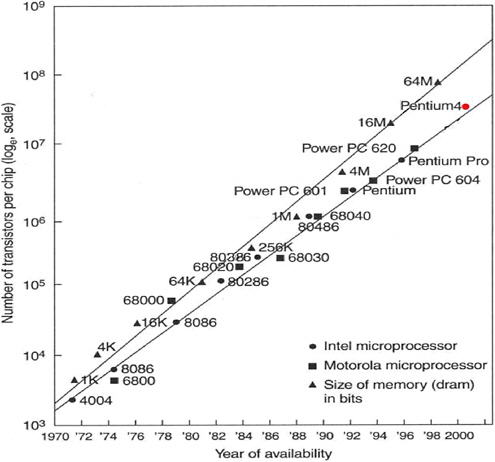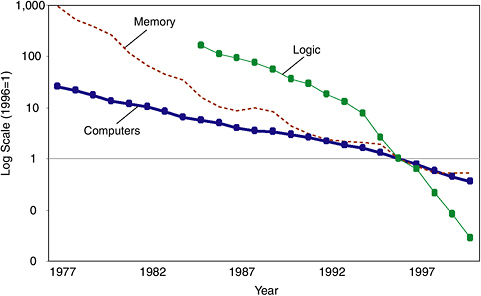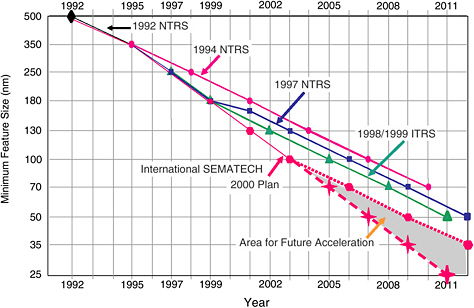Introductory Remarks
Dale W. Jorgenson
Harvard University
Dr. Jorgenson, Chairman of the Board on Science, Technology, and Economic Policy (STEP) of the National Research Council, welcomed those assembled for the day’s symposium, “Deconstructing the Computer,” the second in a series of STEP Board-sponsored meetings devoted to “Measuring and Sustaining the New Economy.” This project focuses on the role of information technology (IT) in the U.S. economy.
Posing the question “Why information technology?,” Dr. Jorgenson offered three answers:
-
Developments in IT have been the main source of productivity growth in the U.S. economy for three decades.
-
This relatively small industrial segment, about 5 percent of the economy in terms of value added, by itself produced the great resurgence of the latter half of the 1990s that put the U.S. economy back on something approximating its historic track of growth.
-
IT had been, in addition, the major force behind a remarkable development of productivity in the years 2001–2002, during which the economy was in a recession.
For these reasons, Dr. Jorgenson explained, the STEP Board had chosen information technology as a launching pad for examining the relationships among sci-
ence, technology, and economic policy. Semiconductors, the bedrock of IT’s development, had served as the subject of the series’ first symposium, “Productivity and Cyclicality in Semiconductors: Trends, Implications, and Questions.”
Dr. Jorgenson proposed summarizing the major findings of that initial conference as a way of providing a context for the day’s meeting. To highlight the speed of technological change prevailing in the semiconductor industry, he cited an analogy formulated in 1998 by Gordon Moore, Chairman Emeritus of Intel Corporation: “If the automobile industry advanced as rapidly as the semiconductor industry, a Rolls-Royce would get half a million miles per gallon, and it would be cheaper to throw it away than to park it.” Dr. Jorgenson specified that Moore’s intent was not to disparage the automobile industry but rather to illustrate how much faster the semiconductor industry had advanced than the rest of the economy as it progressed from the invention of the transistor through the development of the integrated circuit and on to the creation of memory and logic chips. As a second expression of the speed of development of semiconductor technology, he invoked another, more familiar, statement by Dr. Moore commonly referred to as Moore’s Law: “The number of transistors on a chip doubles every 18–24 months.” This he illustrated with the aid of a graph tracing the growth that took place between 1970 and 2000 in the number of transistors per chip for both processing and storage devices (see Figure 1). “What’s remarkable about Moore’s Law,” he declared, “is not just the rapid development that Moore predicted in 1965, but the fact that this has tracked the history of the industry for the subsequent three decades.”
Turning to the impact of the semiconductor industry on the economy, Dr. Jorgenson explained that the economist’s basic task in this case—a very difficult one, he admitted, owing to the rate at which semiconductor technology has developed—is to hold the performance of the device constant while tracking its price. He displayed a chart that plots in logarithmic scale indexes for the prices of computers, memory chips, and logic chips, all of them assigned a value of 1 for 1996 (see Figure 2).
The computer price shows a rate of decline far exceeding the growth of productivity in the U.S. economy: This decline held steady at about 15 percent per year until 1995, at which point it doubled. The rate of decline began accelerating in 1995 for memory and logic devices as well, with the latter showing the most pronounced drop-off of all: At about 40 percent per year until the mid-1990s, it hit about 60 percent per year thereafter. Pointing out that when economists look at price indexes, they usually expect to see a trend going in the opposite direction, Dr. Jorgenson called the price decline of computer prices “a phenomenon” and that of microprocessor prices “stupendous”; the latter, he noted, indicates “very, very rapid” technological change.
Connecting developments in technology to developments in prices is of interest to economists, he said, because these developments are at the heart of the revival of U.S. economic growth and of the trend in productivity that has pre-

FIGURE 1 Transistor density on microprocessors and memory chips.
vailed for the last three decades. Still, he preferred to focus on the period beginning in the mid-1990s, where, he asserted, “the lodestone” is to be found. “What,” he asked, “happened to generate this acceleration in the rate of [price] decline that showed up in computers as well?” To help in examining this question, Dr. Jorgenson displayed a chart that contrasts industry predictions for the increase in miniaturization of semiconductor feature size with the advances actually realized (see Figure 3).
Even though the feature size that in 1995 had been projected for 1998 was reached early, in 1997, the industry remained cautious: Its consensus in 1997 was that the accelerated rate of feature-size decline would continue through 1999 at the latest. In fact, that rate still holds true, Dr. Jorgenson said, and the current

FIGURE 2 Relative prices of computers and semiconductors, 1977–2000.
International SEMATECH roadmap posits that it will continue to hold at least through 2007.1 “Moore’s Law accelerated,” he observed, “and that is precisely what produced the sharp increase in the rate of decline of prices.”
Stressing the significance of this link, Dr. Jorgenson proposed as a goal for the symposium the generation of a series of similar road maps, each covering a different component of computer prices. This would amount to deconstructing the curve representing the evolution of the computer price into curves capturing the changes in technology underlying it. Also on the agenda, he said, is projecting those changes out for a decade or so in hopes of understanding how much of the acceleration in the rate of progress is permanent and how much has been temporary and can be expected to abate, perhaps reverting to its previous pace. Beyond that, telecom equipment, information about whose price trends is now accumulating, and “the very difficult problem of software” were put forward as subjects of similar study.

FIGURE 3 Semiconductor roadmap acceleration.
Dr. Jorgenson then introduced the moderator of the day’s first panel, Steve Landefeld, the Director of the Bureau of Economic Analysis (BEA) of the U.S. Department of Commerce. Identifying BEA as the source of information on IT trends that has been “the key” to understanding the connection between technology and the U.S. economy, Dr. Jorgenson praised the agency for its pioneering use in 1985 of a price index for computers. This index, he noted, would be discussed in detail by the panel’s first speaker, Jack Triplett of the Brookings Institution. He then turned the floor over to Dr. Landefeld.







